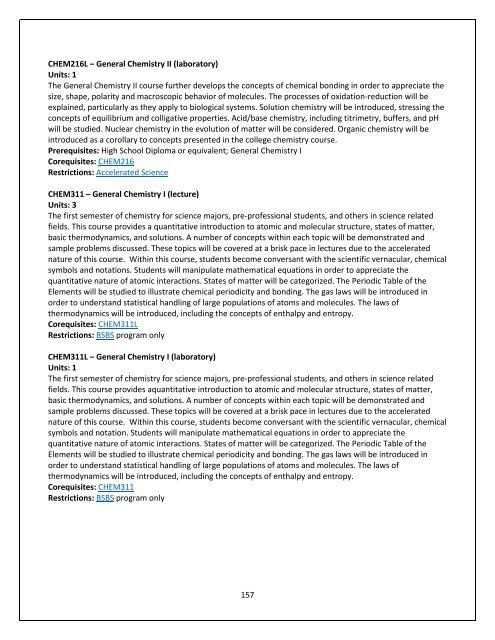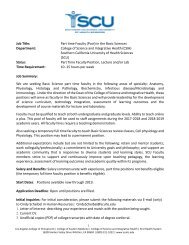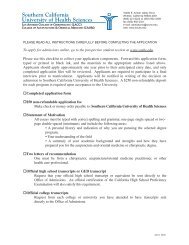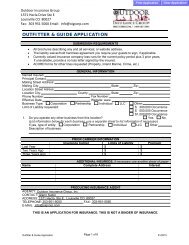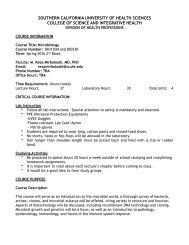Vision, Mission, and Guiding Principles for SCUHS
Southern California University of Health Sciences will be recognized as the premier evidence-based integrative healthcare university. in this PDF we are discussing about our Vision, Mission, and Guiding Principles. Please have a look. you can also go with this link: https://bit.ly/2JuIItL
Southern California University of Health Sciences will be recognized as the premier evidence-based integrative healthcare university. in this PDF we are discussing about our Vision, Mission, and Guiding Principles. Please have a look. you can also go with this link: https://bit.ly/2JuIItL
You also want an ePaper? Increase the reach of your titles
YUMPU automatically turns print PDFs into web optimized ePapers that Google loves.
CHEM216L – General Chemistry II (laboratory)<br />
Units: 1<br />
The General Chemistry II course further develops the concepts of chemical bonding in order to appreciate the<br />
size, shape, polarity <strong>and</strong> macroscopic behavior of molecules. The processes of oxidation-reduction will be<br />
explained, particularly as they apply to biological systems. Solution chemistry will be introduced, stressing the<br />
concepts of equilibrium <strong>and</strong> colligative properties. Acid/base chemistry, including titrimetry, buffers, <strong>and</strong> pH<br />
will be studied. Nuclear chemistry in the evolution of matter will be considered. Organic chemistry will be<br />
introduced as a corollary to concepts presented in the college chemistry course.<br />
Prerequisites: High School Diploma or equivalent; General Chemistry I<br />
Corequisites: CHEM216<br />
Restrictions: Accelerated Science<br />
CHEM311 – General Chemistry I (lecture)<br />
Units: 3<br />
The first semester of chemistry <strong>for</strong> science majors, pre-professional students, <strong>and</strong> others in science related<br />
fields. This course provides a quantitative introduction to atomic <strong>and</strong> molecular structure, states of matter,<br />
basic thermodynamics, <strong>and</strong> solutions. A number of concepts within each topic will be demonstrated <strong>and</strong><br />
sample problems discussed. These topics will be covered at a brisk pace in lectures due to the accelerated<br />
nature of this course. Within this course, students become conversant with the scientific vernacular, chemical<br />
symbols <strong>and</strong> notations. Students will manipulate mathematical equations in order to appreciate the<br />
quantitative nature of atomic interactions. States of matter will be categorized. The Periodic Table of the<br />
Elements will be studied to illustrate chemical periodicity <strong>and</strong> bonding. The gas laws will be introduced in<br />
order to underst<strong>and</strong> statistical h<strong>and</strong>ling of large populations of atoms <strong>and</strong> molecules. The laws of<br />
thermodynamics will be introduced, including the concepts of enthalpy <strong>and</strong> entropy.<br />
Corequisites: CHEM311L<br />
Restrictions: BSBS program only<br />
CHEM311L – General Chemistry I (laboratory)<br />
Units: 1<br />
The first semester of chemistry <strong>for</strong> science majors, pre-professional students, <strong>and</strong> others in science related<br />
fields. This course provides aquantitative introduction to atomic <strong>and</strong> molecular structure, states of matter,<br />
basic thermodynamics, <strong>and</strong> solutions. A number of concepts within each topic will be demonstrated <strong>and</strong><br />
sample problems discussed. These topics will be covered at a brisk pace in lectures due to the accelerated<br />
nature of this course. Within this course, students become conversant with the scientific vernacular, chemical<br />
symbols <strong>and</strong> notation. Students will manipulate mathematical equations in order to appreciate the<br />
quantitative nature of atomic interactions. States of matter will be categorized. The Periodic Table of the<br />
Elements will be studied to illustrate chemical periodicity <strong>and</strong> bonding. The gas laws will be introduced in<br />
order to underst<strong>and</strong> statistical h<strong>and</strong>ling of large populations of atoms <strong>and</strong> molecules. The laws of<br />
thermodynamics will be introduced, including the concepts of enthalpy <strong>and</strong> entropy.<br />
Corequisites: CHEM311<br />
Restrictions: BSBS program only<br />
157


